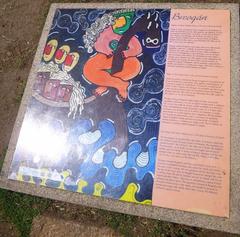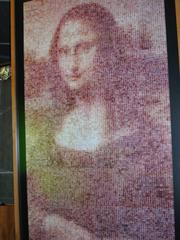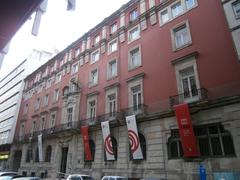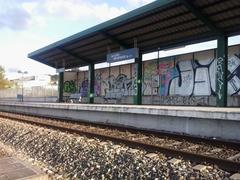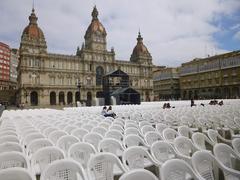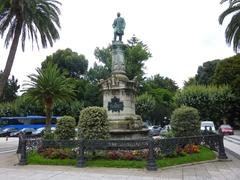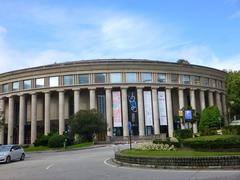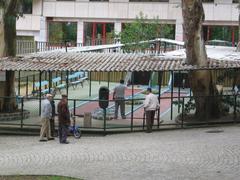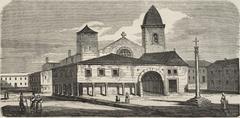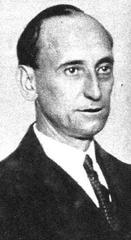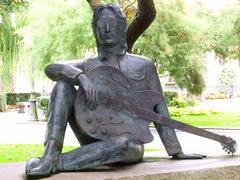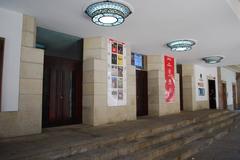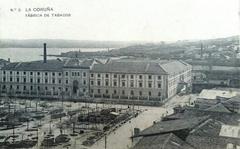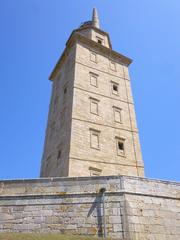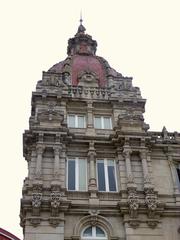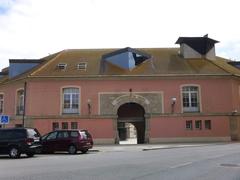
Visiting the Monument to Curros Enríquez in A Coruña, Spain: Visiting Hours, Tickets, and Travel Tips
Date: 04/07/2025
Introduction: A Tribute to Galicia’s Literary Heritage
Nestled in the lush Jardines de Méndez Núñez at the heart of A Coruña, Spain, the Monument to Curros Enríquez stands as a profound homage to Manuel Curros Enríquez—one of Galicia’s most influential poets and champions of the 19th-century Rexurdimento (Galician literary renaissance). Designed by Francisco Asorey and inaugurated in 1934, the monument is more than a commemorative statue; it is a living emblem of Galician culture and identity. This comprehensive guide covers the monument’s history, artistic features, visiting information, nearby attractions, and practical tips, offering everything you need for a memorable visit.
For the latest updates and visitor resources, refer to A Coruña Tourism Office and Audiala.
Table of Contents
- Introduction
- About the Monument
- Historical Context and Significance
- Artistic Design and Symbolism
- Visiting Hours and Admission
- Accessibility
- Getting There
- Guided Tours and Events
- Best Times to Visit and Photography Tips
- Manuel Curros Enríquez: Life and Legacy
- Visitor Experience and Practical Information
- Nearby Attractions
- Local Customs and Etiquette
- Safety and Amenities
- Events and Cultural Activities
- Practical Tips
- Frequently Asked Questions (FAQ)
- Plan Your Visit
- References
About the Monument
The Monument to Curros Enríquez celebrates the enduring legacy of Manuel Curros Enríquez (1851–1908), a pivotal figure in Galician literature and social advocacy. Sculpted by Francisco Asorey, the 3.3-meter granite and bronze ensemble depicts Curros with his “lira de ferro” (iron lyre), symbolizing the poetic voice and the struggle for Galician identity. Surrounding him are figures representing the Galician people, emphasizing collective resilience and cultural pride.
The monument’s placement within the Jardines de Méndez Núñez—a historic green space central to A Coruña’s social life—anchors it as a vital touchstone of Galician heritage (La Opinión A Coruña).
Historical Context and Significance
Manuel Curros Enríquez was a leading voice in the Rexurdimento, a period of cultural and linguistic revival in Galicia. His poetry, particularly “Aires da miña terra,” championed social justice and regional pride, often challenging political and ecclesiastical authority. Despite facing censorship and excommunication, Curros Enríquez’s work sparked lasting literary and civic movements.
The decision to honor him with a monumental sculpture in A Coruña reflects his profound connection to the city and the deep respect he commanded. The site continues to serve as a gathering space for cultural commemorations and public events (artenoafonsox.blogspot.com).
Artistic Design and Symbolism
Structure and Composition
- Central Figure: Curros Enríquez stands in a dignified pose, cape draped, holding a lyre—a nod to his poetic vocation and the transformative power of art.
- Base and Reliefs: The granite pedestal features high-relief scenes of Galician rural life—peasants with oxen, women with children—framing the poet’s advocacy for the working class (patrimoniogalego.net).
- Symbolic Motifs: The ship’s keel form and dolmen-like blocks evoke Galicia’s Celtic past, while bas-reliefs and inscriptions in Galician underscore regional identity. The base is surrounded by native flora and water features.
- Allegorical Figures: Atop the monument, a nude female form with raised arms—an allegory of Galicia—crowns the ensemble, representing hope and the apotheosis of the region (gl.wikipedia.org).
Interpretive Elements
- Galician Language and Culture: Inscriptions and artistic choices celebrate the Galician language and the poet’s fight for its recognition.
- Social Justice: Figures of peasants and fishermen reflect Curros’s solidarity with marginalized communities and his advocacy for equality.
- Resistance and Renewal: Laurel wreaths, books, and expressive gestures symbolize resilience, education, and the enduring vitality of Galician heritage.
Visiting Hours and Admission
- Location: Jardines de Méndez Núñez, A Coruña, Spain
- Hours: Open daily, year-round; gardens typically accessible from dawn until dusk (approx. 8:00 AM – 10:00 PM in summer)
- Admission: Free—no tickets required
The monument is outdoors and can be visited at any time during garden opening hours. Daylight is recommended for optimal viewing and photography.
Accessibility
The Jardines de Méndez Núñez and the Monument to Curros Enríquez are generally wheelchair and stroller accessible, with paved and well-maintained paths. Some sections may have minor uneven surfaces, but the primary approaches are suitable for visitors with mobility needs. Public transport options nearby also offer accessible services.
Getting There
- On Foot: Centrally located, the monument is easily reached from A Coruña’s Old Town and major squares.
- By Bus: Multiple city bus lines stop near the gardens—check local schedules for details.
- By Car: Paid parking is available in nearby underground garages; spaces may be limited, so public transport or walking is recommended.
Guided Tours and Events
While the monument does not offer official tours, many city walking tours and cultural itineraries include it as a highlight. Local guides provide context about Curros Enríquez, A Coruña’s literary heritage, and the monument’s symbolism. Seasonal events—especially on Galician Literature Day (Día das Letras Galegas)—feature poetry readings and commemorations at the site (A Coruña Tourism Office).
Best Times to Visit and Photography Tips
- Season: Spring and early autumn provide mild weather and vibrant garden scenery.
- Time of Day: Early morning or late afternoon offers softer natural light and fewer crowds—ideal for photography.
- Photo Tips: Capture the monument with the lush park as a backdrop. Consider multiple angles to highlight the reliefs and allegorical figures.
Manuel Curros Enríquez: Life and Legacy
Curros Enríquez’s enduring influence stems from his commitment to social justice, regional identity, and linguistic pride. His funeral in A Coruña drew an estimated 40,000 mourners, underscoring his impact. Today, his work continues to inspire writers, activists, and those passionate about Galicia’s cultural revival (artenoafonsox.blogspot.com).
Visitor Experience and Practical Information
- Atmosphere: The monument’s setting in the tranquil Méndez Núñez Gardens encourages reflection.
- Interpretive Signage: On-site information is limited; consider reading about Curros Enríquez or the Rexurdimento beforehand.
- Restrooms and Amenities: Public facilities and benches are available in the gardens.
- Food and Refreshments: Numerous cafés and restaurants surround the park. Picnicking is permitted in designated areas.
Nearby Attractions
- Kiosco Alfonso: Exhibition space for contemporary art and culture.
- Teatro Colón: Historic theater adjacent to the gardens.
- Obelisco dos Cantóns: Iconic monument nearby.
- Praza de María Pita: A Coruña’s main square, filled with historic buildings and local eateries (visitsights.com).
Local Customs and Etiquette
- Learn a few words in Galician or Spanish to connect with locals.
- Respect the monument and gardens by not climbing on structures or disturbing plantings.
- Be considerate when photographing, especially during events or busy times.
Safety and Amenities
A Coruña is considered safe, with regular police patrols in public parks. Emergency services can be reached by dialing 112. The area is well-lit and frequented by locals and tourists alike.
Events and Cultural Activities
The monument is a focal point for cultural events, including poetry readings, civic celebrations, and educational programs. Check ahead with the A Coruña Tourism Office or local media for event schedules.
Practical Tips
- Use public transport or walk to avoid parking challenges.
- Bring an umbrella or raincoat if visiting outside summer months due to Galicia’s variable weather.
- Download maps or use virtual tours for planning, especially if interested in the garden’s layout and connected landmarks.
- For a deeper experience, read Curros Enríquez’s poetry or learn about the Rexurdimento before visiting (visitaalosjardinesdemendeznunez.home.blog).
Frequently Asked Questions (FAQ)
Q: What are the visiting hours for the Monument to Curros Enríquez?
A: The monument is accessible during Méndez Núñez Gardens’ opening hours, typically from dawn until dusk, year-round.
Q: Is there an entry fee or ticket required?
A: No, entry to the monument and gardens is free.
Q: Are guided tours available?
A: Many city walking tours include the monument; check with the A Coruña Tourism Office for current offerings.
Q: Is the monument wheelchair accessible?
A: Yes, most garden paths and the monument area are accessible, but some assistance may be required on uneven surfaces.
Q: What’s the best time to visit?
A: Spring and early autumn for mild weather; early morning or late afternoon for best light and fewer crowds.
Plan Your Visit and Stay Connected
For the latest information on guided tours, cultural events, and visitor tips, consult the A Coruña Tourism website or download the Audiala app. Stay updated on upcoming events, and explore more about A Coruña’s cultural treasures by following official tourism channels and local news outlets.
Summary
The Monument to Curros Enríquez stands as a testament to Galicia’s literary and cultural vitality. Open year-round with free admission and set within the beautiful Jardines de Méndez Núñez, it offers visitors a unique opportunity to engage with the region’s heritage. Plan your visit to coincide with local events or simply enjoy the monument’s artistry and tranquil setting. For further exploration, combine your visit with nearby attractions and immerse yourself in the legacy of one of Galicia’s most celebrated poets (La Opinión A Coruña).
References
- Visiting the Monument to Curros Enríquez in A Coruña: History, Hours & Tips, 2025 (A Coruña Tourism Office)
- Monument to Curros Enríquez in A Coruña: Visiting Hours, Tickets, and Historical Significance, 2025 (Audiala)
- Complete Visitor’s Guide to the Monument to Curros Enríquez in A Coruña, 2025 (La Opinión A Coruña)
- Visitor Experience and Practical Information for the Monument to Curros Enríquez in A Coruña, 2025 (visitsights.com)
- Monumento a Curros Enríquez (gl.wikipedia.org)
- Francisco Asorey: Monumento a Curros Enríquez (artenoafonsox.blogspot.com)
- Monumento a Curros Enríquez (patrimoniogalego.net)
- Monumento Curros Enríquez (visitaalosjardinesdemendeznunez.home.blog)



